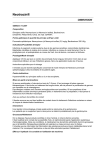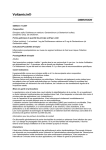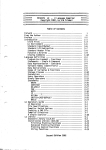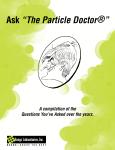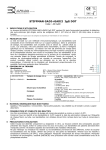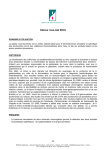Download DR. Chip DIY Kit User's Guide
Transcript
DR. Chip DIY TM Kit User’s Guide DR. Chip DIYTM Kit Polymer substrate and colorimetric reagents for microarray User’s Guide DR. Chip Biotech No. 31, Ke Jung Road. Science-Based Industrial Park, Chu-Nan, Miao-Li, Taiwan 350 TEL: +886-37-585-585 FAX: +886-37-585-586 Email: [email protected] http://www.bio-drchip.com.tw DME-CD-1129-B DR. Chip DIY TM Kit User’s Guide DR. Chip DIY TM Kit User’s Guide DR. Chip DIY TM Kit User’s Guide PRODUCT DESCRIPTIONS GENERAL INFORMATION Product Characteristics DR. Chip DIYTM Kit is a ready to use polymer substrate and colorimetric reagents system. The kit provides a complete set of reagents for making microarray from probe immobilized, hybridization, blocking to color signal reaction. The kit is designed to combine fast hybridization technology and let you to design micro array easily. The polymer substrate can be used with automatic spotting machine and manual spotting machine. DR. Chip DIYTM Kit is a cost effective system. You do not need to pay the high cost glass substrate, fluoresce reagents and expensive fluoresce reader. The colorimetric system even allows you to use your naked eye to view the results. Of course, you can also choose a special designed colorimetric reader, DR. AiMTM reader, to avoid human errors. DR. Chip DIYTM Kit provides you a low cost entrance for the microarray world. 1 Hyb Buffer 2 Wash Buffer 3 4 5 SPECIFICATIONS Store at 2-8oC No Descriptions 1 DR. HybTM Buffer 2 Wash Buffer 3 Strep-AP 4 Blocking Reagent 5 Detection Buffer 6 NBT/BCIP 2 × Probe solution 7 DR. Chip 8 Volume 60 mL 200 mL 55 mL 60 mL 120 mL 1.2 mL 1.2 mL 96 Rx Quantity 1 bottle 1 bottle 1 vial 1 bottle 1 bottle 1 vial 1 vial 32 packs 6 7 12 Specially formulated to facilitate the hybridization of specific oligo probes with analytic sample. Stringent washing to remove the residual of reacted liquids. Using the specificity of biotin and streptavidin to detect the biotinylated molecules of amplicons. The streptavidin conjugated alkaline phosphatase Strep-AP as enzyme to react with its substrate NBT/BCIP for colorimetric signal on the chip. Specifically formulated to reduce non-specific Blocking Reagent nucleic acid binding on polymer chip surfaces, also as a dilution buffer for Strept-AP. As a dilution buffer for NBT/BCIP, formulated to Detection Buffer ensure the activity of alkaline phosphatase. Chromogenic phosphatase substrates. Hydrolysis of BCIP (5-Bromo-4-chloro-3-indolyl phosphate indolyl phosphate), followed by oxidation, produces a blue-colored precipitate at the site of enzymatic activity. NBT (Nitro blue tetrazolium) is NBT/BCIP the most commonly used electron-transfer agent and co-precipitant for the BCIP reaction, forming a dark blue, precisely localized precipitate in the presence of alkaline phosphatase. 2 × Probe It is a synergy reagent to increase the compatibility of nucleic probe and Biochip. solution It’s a unique polymer substrate of special surface DR. Chip treatment. DR. Chip DIY TM Kit User’s Guide STORAGE CONDITIONS Please store at 2-8oC upon delivery.DR. Chip DIYTM Kit has demonstrated stability over 12-month period when stored at recommended temperatures; however, we recommend the kit should be discarded when reach expiry date. . PRECAUTION Only appropriately trained molecular laboratory personnel shall operate this system. All protocols in this manual shall be followed. Gloves shall be worn at all time. In case of contact with eyes, rinse eyes immediately with plenty of water. Do NOT touch the surface of the chip. MATERIALS REQUIRED BUT NOT PROVIDED Instruments Micropipettes Vortex mixer -20℃ Freezer Hot plate DR. Easy Spotter Hybridization oven (Optional) Microcentrifuge DR. AiM Reader (optional) Consumables 96 well PCR tubes Tips 1.5 mL microcentrifuge tubes DR. Chip DIY TM Kit User’s Guide 2. According the probes pattern microarray, using the DR. Easy spotter or automatically spotting machine to stain the prepared probe solution on the polymer substrate. 3. After all of the prepared probes has been spotted on surface of chip, please dry the substrate about 5~10 minutes, and put the substrate into UV crosslinker for immobilizing the probes about 5 minutes (suggest use UV light as 254 nm/0.8 ~ 1.8 J ) III. Post washing & Dry 1. Transferring the chip into 500 mL Mili-Q or RO H2O immerse about 5 min and discard the liquid. (Repeat step 1 two times) 2. Add 100 µL 95% alcohol about 30 second and discard the liquid. 3. Dry the chip at 50℃ oven about 10 minutes. IV. Hybridization Hybridization Reaction 1. Denature the analytic PCR product for 10 minutes, and cool down to 4℃by PCR machine. During the denaturing time, pipette 200µL hybridization buffer (Store at 2~8℃) into Chip to wait for hybridization. 2. Pipette 1 ~ 25 µL denaturing PCR product into chip which had been loaded the hybridization buffer before and incubate at optimal hybridization temperature in DR. Chip hybridization oven with vibration for 0.5~1 hour.. (*Note: you have to tune your own condition, because the different molecular weights of PCR products have different affinity and temperature for hybridization) PROTOCOLS I. The preparation of Spotting Probe solution Taking 25μL oligonecleotide probe (20~40μM) mix well with 25μL 2 × probe solution in 1.5 mL microcentrifuge tube, and transfer in 96 well PCR tube. (The final concentration of spotting probe solution is 10~20μM) II. Spotting and immobilization 1. Before the chip spotting, put the DR.Chip into the 45℃ oven to dry for 10 minutes in order to remove the moisture on chip surface. 3 V. Stringent Wash 1. Discard the hybridization liquid. 2. Add 250 µL Wash Buffer into the chip and discard the wash liquid; repeat this wash step twice. VI. Blocking 1. For each chip mixes 0.25 µL Strep-AP with 250 µL Blocking Reagent; 4 DR. Chip DIY TM Kit User’s Guide DR. Chip DIY TM Kit User’s Guide transfer the mixture into the chamber, and allowing reaction for 30 minutes at room temperature (25~35 oC). Discard the reacted blocking reagent and add 250 µL Wash Buffer into the hybridization chamber and then discard the wash liquid; repeat this wash steptwice. After step 2, place upside down the chip on paper towel to absorb residual liquid. II. Sample Preparation & Results analysis procedure VII. Colorimetric Development 1. Mix 5 µL NBT/BCIP with 245 µL Detection Buffer for each chip, transfer the mixture to the chip. 2. Allow reaction to occur in the dark for 5-10 minutes at room temperature. 3. Discard the detection liquid, then rinse the chip with 300μL water twice and read the results of the developed pattern on the chip. Hybridization with chip probes 2. 3. VIII. The simplified flow chart of DR. Chip DIYTM Kit protocol I. Chip making procedure Nucleic acid Extraction (DNA or RNA) Target gene amplification (RT-PCR, PCR or others) Stringent Wash Blocking Stringent Wash Colorimetric Development Probes solution preparation Results analysis Spot probes on chip Immobilize probes on chip with UV cross linking Post wash & Dry Chip Ready to use 5 6







